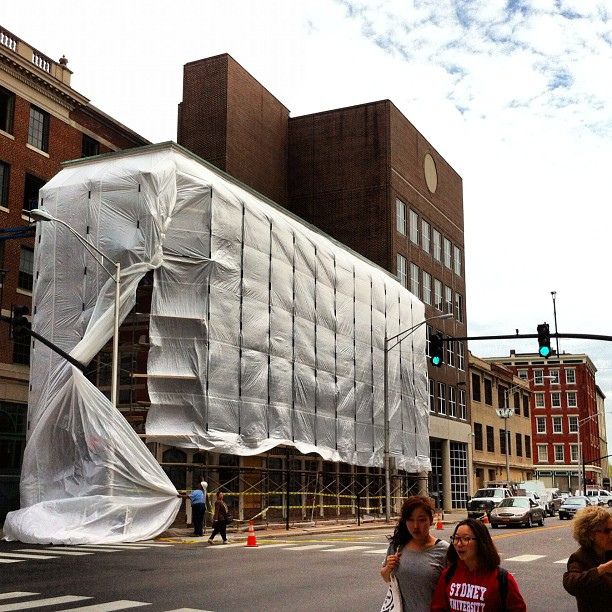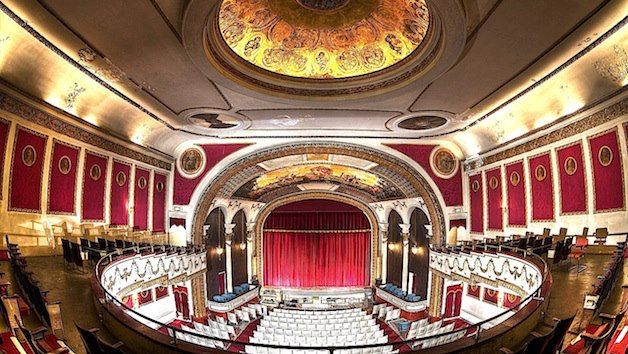WARWICK | THE STATION DISTRICT
Ripe for development
City envisions ‘new downtown’ of homes, businesses
By BARBARA POLICHETTI JOURNAL STAFF WRITER
WARWICK — Can trains, planes and automobiles pull an old industrial area out of the doldrums and boost the state’s economy by attracting new businesses?
City and state officials hope so.
They want to capitalize on what they see as a winning transportation combination: T.F. Green Airport connected to a new train station via sky bridge — all within a half mile of easy highway access.
The area around the transportation hub that the city thinks is ripe for redevelopment has been identified as roughly 100 acres of privately owned land in the heart of the city along Jefferson Boulevard and Post Road.
It is referred to as the “Station District,” and officials hope it becomes Warwick’s new downtown with offices, hotels, shops and urban-style residences, such as apartments and loft condominiums. The city also envisions a well-planted, attractive streetscape that will entice residents to walk the area rather than drive.
Even though it will probably take years to become reality, Governor Chafee says the Station District has great potential and getting it off the ground is one of his top priorities.
“I see this area now as one of our most important assets,” Chafee said. “If there’s a company interested in coming to Rhode Island, this is one of the first places I will take them.”
City officials say they are banking on the easy access to transform a faded part of the city that was once a mill village and later a manufacturing and industrial area.
“When you want to get an area ready for development, the first thing you look at is your infrastructure and what you have in place,” Mayor Scott Avedisian said. “Well, we have it all in one place — an airport, a train station, bus service and great access to Routes 95 and 295.”
To lure developers, the city has created new zoning for the area that will allow for denser development. Buildings can be taller, closer together and built right up to the sidewalk.
William DePasquale, the city’s planning director, said having buildings nudge the sidewalk is a return to the look and feel of an old-fashioned downtown. The Station District is now the only area in Warwick where buildings do not have to be set back from the pavement.
“We want that pedestrian interaction, DePasquale said.
“We want an active streetscape with restaurants and shops on the ground level. Also services like dry cleaners or shoe repair shops — the types of places that people stop in often.”
Mayor Avedisian noted that Warwick does not have a traditional downtown. Rather, its older retail areas are made up of a collection of small village centers.
For the Station District, he said, “I can see someone taking the commuter rail home, going to their apartment and condo to change, and then enjoying the evening at a local restaurant with friends — without ever having to use their car.”
Warwick’s vision for what is now a scruffy-looking area has been discussed and revised numerous times since the idea was broached more than 15 years ago when Governor Chafee was mayor of the city.
The impetus, Chafee recalls, was discussion in the mid 1990s about Amtrak’s desire to build a train station near the airport.
Over the years, Amtrak bowed out and the state Department of Transportation and Rhode Island Airport Corporation stepped in to see the station project through. The result was a $267-million complex called the InterLink that features a rail station served by the Massachusetts Bay Transit Authority, car rental companies and a large parking garage with room for the rental fleets and commuters.
The complex, which opened in the fall of 2010, is linked to Green via a sky bridge that crosses Post Road and which officials say offers not only convenience, but protection from unpredictable New England weather. Chafee said it was designed to accommodate at least a couple of buildings that want to “dock” directly to it, so there is the possibility of travelers being able to enter a hotel or other business right from the skyway.
Chafee says he remains as enthusiastic about the transportation hub as he was from the beginning. And like local officials, he sees the development zone as the perfect New England spot for corporate conferences.
Participants could arrive at Green, walk across the sky bridge to a hotel hosting the conference and then fly out — without ever needing a car, he said. If they decided to explore Rhode Island a bit, the rental car companies are right there.
Avedisian said that the Station District is a way for War-wick to capitalize on having a regional airport in its midst ––an airport that is undergoing a $165-million improvement and runway expansion project, and which also just welcomed JetBlue as another affordable carrier.
The idea of using transportation to seed development, particularly in urban areas, has been a successful formula across the country for at least 20 years.
National urban development expert Christopher B. Leinberger is familiar with dozens of so-called “transit-oriented districts” — from Oregon to Virginia. Warwick’s hope for a concentrated mix of retail, office space and residences is typical, he said.
What is not so typical, he said, is Warwick’s reliance on commuter rail linked to an airport.
Airports in and of themselves do not generally kindle development around them, Leinberger said, and there is little case history to show whether an air-commuter rail link can attract enough development to sustain a new district.
“That’s not to say it won’t work,” he said.
Leinberger is president of Locus, a national consortium of real estate developers who work in partnership with Smart Growth America to advocate for sustainable and “walkable” urban development. He is also a senior fellow at the Brookings Institution, a nonprofit public policy think tank based in Washing-ton, D.C.
The typical recipe for success, he said, is abundant ground transportation that offers frequent stops, such as subways and trolleys. He also said that while there is great demand for pedestrian-friendly urban areas across the country, they “take a lot of hard work” and many never get off the drawing board.
DePasquale and senior city planner Dan Geagan, who have been immersed in the details of the Station District for more than a decade, say they are aware of the challenges and are not daunted.
Neither is state Planning Director Kevin Flynn.
“You have the real possibility of creating a true, mixed-use walkable downtown type area there,” he said. “You could totally transform the area and you have the potential to create something we don’t have in the state.”
Regarding concerns that an airport may not be a big draw for developers, Flynn said, “The airport has been there for years, but now we have the added element of rail.
“That is the infusion of something new.”
While about 200 commuters a day use the Warwick train station currently, city officials believe that the number will grow. Flynn and DePasquale noted that it takes years to grow ridership on any public transportation system.
“It takes time to mature a commuter population,” De-Pasquale said. “We know this, and that is why the residential component is such an important part of the Station District plan.”
Once loft-style condominiums or other attractive urban residences get people living in the Station District, their reliance on the commuter rail could make it practical for the MBTA to increase service on the line, he explained.
One of the scenarios the city sees for the area would be a mix of 40 percent to 45 percent office and hotel space, 10 percent to 20 percent retail and entertainment and 40 percent to 45 percent residential.
DePasquale and Geagan said the city’s zoning incentives should draw interest from developers — plus the city plans to streamline the permitting process for new development. Also, the city is ready to help developers contact landowners in attempts to secure parcels they want to develop.
While the city is working on writing design guidelines for the district, Avedisian said, it will not dictate building materials or an architectural style. DePasquale said the city wants to be flexible, right down to the boundaries of the district itself. He said the city can easily expand the district to include surrounding properties, such as the old textile mill that most recently housed Leviton, an electronics component maker.
The city is not currently offering developers monetary incentives, such as phased-in property taxes.
Officials are concentrating on marketing the district with the help of the governor’s office and other state departments.
Earlier this month the city learned it had won a $400,000 grant from the U.S. Department of Transportation, primarily for marketing the Station District. Also, working with the state, the city has already begun bringing in real estate scouts from across the country for tours of the district.
“Now we have to get out there and buck this inclement economy,” Chafee said. “We want to make sure this is on everyone’s radar.”
An advantage Warwick has, city officials say, is that it is focusing on a small area. Transportation districts in other parts of the country are often much larger, connecting many communities and covering anywhere from a few square miles to several-hundred square miles.
When asked for a prime example of a successful transportation district, most professional planners look west and point to Portland, Ore., for its use of mass transit to keep a major city vital while also sparking development in surrounding areas. The gargantuan “TriMet” transportation system that serves the area offers electric trains, commuter rail and streetcars — all combining to create an impressive network that serves Portland and more than two dozen other cities across three counties.
The rail system has seeded a few high-density, mixed-use developments in the 570 square miles it serves. In the Orenco Station community, a planned development zone west of Portland, residents can access the giant mass transit system while living in a pleasant tree-lined area where they can walk to almost any amenity.
Imagination is needed to picture the Station District as the city hopes it evolves, Avedisian and Chafee acknowledge.
The area is a patchwork of privately owned parcels and a mix of mismatched businesses ––– many of which are located in one-story, cinder-block buildings. There are a couple of remaining rows of old millworker houses, vacant lots and, right beneath the sleek glass-walled sky bridge, an overgrown “graveyard” for worn-out lemonade trucks.
“I see affordable property when I look at that,” Chafee said, noting that real estate in Warwick is far more affordable than Boston or New York. DePasquale said the city has compared housing costs with Boston suburbs on the MBTA line and found that you can live in Warwick for about 30 percent less.
Skeptics, Avedisian said, need only to look at what the area looked like 10 to 15 years ago.
Part of the land where the train station and parking garage now stand had been home to the former T.H. Balis chemical company, he said. “We have to remember where we’ve been,” he said. “This is an opportunity to create a new sense of place in Warwick — and that’s an opportunity you don’t get very often.
“We need to make sure we get this right.”
bpoliche@providencejournal.com (401)277-8065




